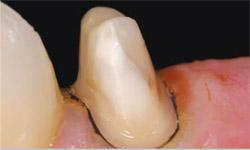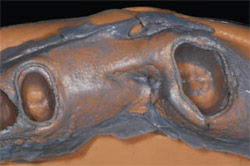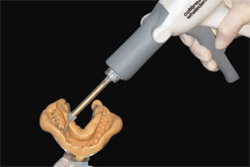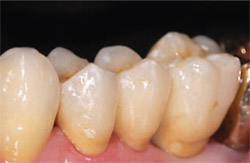A Systematic Method for Preparing Good Putty-Wash Impressions
All good prosthetic work is based on the perfect impression. The current theoretical marginal accuracies of 50 µm for fixed dentures are only possible if the technician receives a sharp and bubble-free impression of the preparation margin as a working template. However, this objective can only be achieved successfully if a consistent system is followed using the appropriate high-quality materials.
A CONSISTENT PROCESS
In this Technical Profile from Coltène/Whaledent, we follow a clinical case from the practice of Dr. Wolfgang Boer. Dr. Boer always starts with a hygiene phase adapted for patient-specific requirements. Systematic work is simply impossible if the gingiva starts bleeding at the lightest contact. Before the hygiene phase, only emergency treatment is given and temporary dentures are used for restorations. Conservation and surgical treatment (if necessary) are not begun until the periodontium is clean and insensitive to touch. All abutment fillings for the fixed denture are cemented in and any required endodontic treatment is conducted. Only at this stage is the final prosthetic plan prepared, thus preventing any surprises during preparation that could delay treatment or even require a change of plan.
The actual preparation should be as atraumatic as possible for the gingiva. For this reason, Dr. Boer does not place a retraction cord first, as is frequently recommended, because retraction cords are frequently caught in rotary instruments. Instead, the gums are protected from injury by rotary instruments by the use of suitable retainers. At the same time, the doctor attempts to keep the preparation margin as supragingival and as straight as possible. The objective should be to ensure that the gingival margin remains predictably where it was before preparation, even after delivery of the restoration to prevent subsequent uncovered crown margins.
If retraction cords are forced into the pocket at too high a pressure, there is a danger of detachment of the gingival margin and violation of the biological width. Therefore, this step should never be conducted by an assistant.When using the double-cord method, Dr. Boer always places a cord that is as thin as possible, which disappears into the gingival margin, and then a second cord of appropriate thickness is placed directly at the same height as the preparation margin (Figure 1).
Despite doubts about the dimensional behavior, Dr. Boer still favors the classical putty-wash impression with A-silicones for crown-and-bridge prosthetics because, in his experience, it guarantees the safest and most predictable impression sharpness in the critical marginal region. This places specific demands on the impression material. Unlike the dual-mix or sandwich technique, the extremely viscous putty material should reach a particularly high-end hardness to minimize elongation during the impression. In contrast, the light-body material should be of a low enough viscosity to allow the excess material to flow away without difficulty and to create a correction layer that is as thin as possible. A typical problem with many wash materials is the development of bubbles at the preparation margin as a result of the hydrophobic behavior of the silicone in contact with the moist dentin. A simple assessment of the quality of the impression is necessary to be able to continue the treatment plan, so it can be repeated immediately if necessary if the initial result is unsatisfactory. This avoids having the patient attend another treatment session.
USING SUPERIOR MATERIALS
The new AFFINIS® PRECIOUS (Coltène/Whaledent Inc, Cuyahoga Falls, OH) has given the best results of all the A-silicones that the Dr. Boer has tested in his practice. The putty material is available in various degrees of hardness and consistency. In this case, the AFFINIS Putty Soft was used for the preliminary impression.
The AFFINIS PRECIOUS wash material is colored with metal particles and has a gold sheen (regular body) and a silver sheen (light body). The resulting contrast makes the finished impression much more legible and, therefore, much more accurate for the technician compared to the conventional combination of light and dark or complementary shades from other manufacturers. AFFINIS PRECIOUS does appear slightly firmer than the predecessor material, but this is not a negative aspect when it comes to using it. In contrast, the flow behavior of the wash compound is retained and it can even be compared favorably with polyethers because it does not flow uncontrollably when coating multiple stumps. The wetting capacity of moist dentin and also the surrounding soft tissue is surprisingly good (Figure 2 and Figure 3).
Since Dr. Boer started working with AFFINIS PRECIOUS, he has not had to repeat an impression because of bubble formation at the preparation margin. However, if any inaccuracies do appear, the legibility of the silver light-body material shows them clearly (Figure 4).
The process of coating the preliminary impression with wash material from the standard 50-ml cartridges is always rather difficult. The conventional dispensers and mixing tips require manual strength, and the resulting hand tremors are amplified by the long lever between the hand and the end of the mixing tip.
Application with the microSystem™ (Coltène/Whaledent) makes the work much easier (Figure 5). The cartridges, which only contain 25 ml, and the corresponding oral tips are more flexible than standard cartridges. Additionally, they require much less strength to use and can be applied more accurately to the preliminary impression because the lever is shortened by about one third.
Dr. Boer has had excellent results with AFFINIS PRECIOUS and it is the ideal supplement to his working system (Figure 6). It provides him with the security that another impression will not be required because inaccuracies were found on the finished cast in the laboratory.
This article was adapted from: Dentalzeitung. 2007;49(2):283-285.
For more information, contact:
Coltène/Whaledent Inc
Phone: 330-916-8800
Web: www.coltenewhaldent.com
DISCLAIMER
The preceding material was provided by the manufacturer. The statements and opinions contained therein are solely those of the manufacturer and not of the editors, publisher, or the Editorial Board of Inside Dentistry. The preceding is not a warranty, endorsement, or approval for the aforementioned products or services or their effectiveness, quality, or safety on the part of Inside Dentistry or AEGIS Communications. The publisher disclaims responsibility for any injury to persons or property resulting from any ideas or products referred to in the preceding material.
 |  | |
| Figure 1 Prepared tooth No. 14 after the placement of retraction cord. | Figure 2 and Figure 3 The light-body material AFFINIS PRECIOUS is applied around the preparation and also pushed into the sulcus with a gentle flow of air (air-blow technique). | |
 |  | |
| Figure 4 The excellent legibility of the outstanding contrast behavior of the silver wash material is immediately apparent when judging the finished impression. | Figure 5 Application with the Coltène/Whaledent microSystem dispenser is safe and accurate, even for smaller hands. | |
 | ||
| Figure 6 The metal-ceramic bridge immediately after cementing. |



